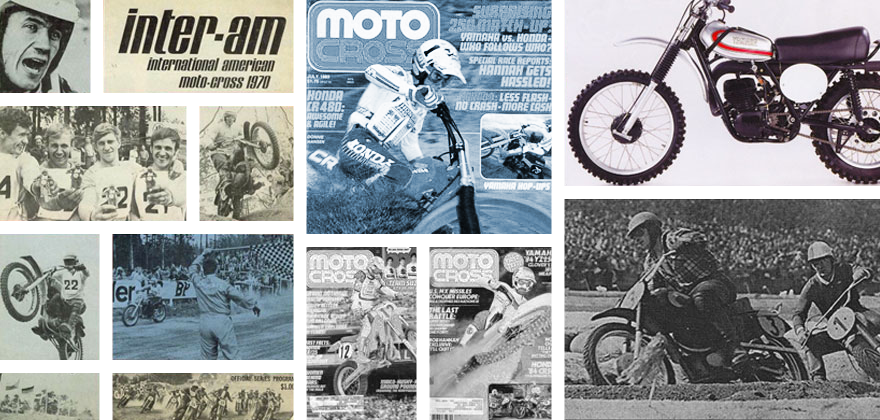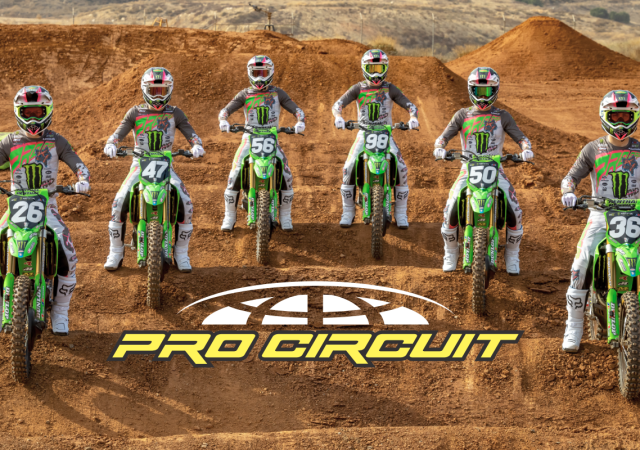Ducati invited us to come test ride their very first motocross machine, the Desmo 450 MX. I hopped on a plane to Bologna, Italy to take a quick tour of the factory as well as ride the new red machine at 04 Park-Monte Coralli. Unless you’ve been living under a rock, Ducati’s desmodromic valve is a reciprocating engine poppet valve that is positively closed by a cam and leverage system, rather than by a more conventional spring. This is nothing like we have seen in the motocross world and is proprietary to Ducati. How did the engine as well as the other important pieces of the machine work in it’s homeland in Italy? Here are some key things I learned while getting to spend the day on the Desmo 450.
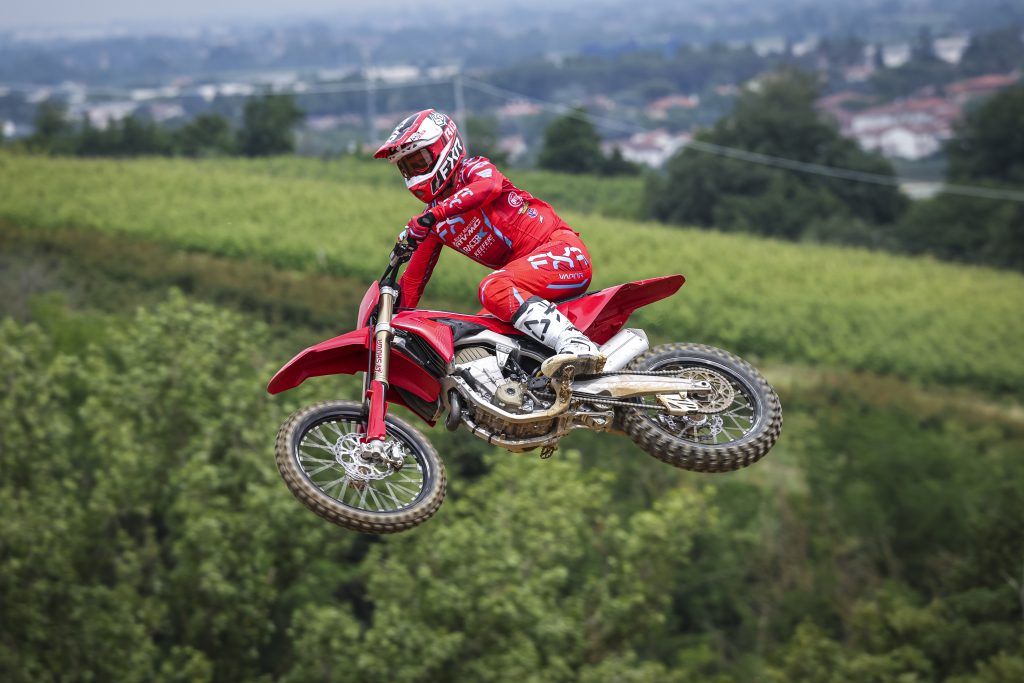
Desmodromic Engine Feel: I heard a few of the other media members say that the engine was nothing like they felt before but to be honest (for me) the engine delivery wasn’t that drastic of change compared to other standard engine designs. Yes, the engine does spool up quickly and have a very free feeling rev but it is a very linear/smooth type of delivery to the rear wheel. What is unique however about the Desmo engine feel is that even though it does spool up quickly it doesn’t make the rider quickly shift once out of the corner. Like other models that spool up quickly this Desmo engine feels like it can pull second and third gears longer than any other brand I have felt to date. Ducati made the rev cut at 11,900 RPM but it feels more like a 13,000 to me when riding. I mean if there is motorcycle company that can make an engine rev, it would be Ducati.
This engine isn’t going to blow you away with engine excitement down low, instead it will build power more calculated and give you a sense of it almost feeling slow off the bottom. That is until it hits the mid range and once you get there, you better hang on because the Desmo puts the power to the rear wheel effectively once transitioned over 6000 RPMs. As noted the top end and over-rev (feels) unmatched but we will have to dive into that more when we get our own back at home. I did notice a little rich ECU setting below 6000 RPM and to me if Ducati cleaned this up a little the connection below 6000 RPM will be even better. I noticed that when I I was trying to set up for slower corners the Desmo would have a small dirty feel that left some disconnection when trying to get on the throttle between area 1 and 2 of a few corners on the track. This dirty feel would make the Ducati feel slightly heavy on tip in of corners that were slow/tight. I heard that the units we were testing were pre-production units so Ducati told me that the ECU mapping was not final on the bikes we tested, which is a good thing for you consumers.
Ducati Chassis: It was hard to really deep dive the chassis at the Italian 04 track that we rode as it was fairly smooth. I can tell you that at the time of the test, I din’t feel like the chassis was rigid feeling. The 04 track was hard pack so I should have felt some sort of rigidity if it was apparent and I didn’t feel like it was harsh in any way. I also appreciated that the bike didn’t vibrate and had a quality feel to it through the bars and pegs. For those wondering if it felt like a Honda chassis and I can tell you that it does not feel like a Honda much at all. The initial lean in (or tip in into corners) was heavy (maybe due to the ECU setting) but after area one the Ducati tracks into ruts/flat corners well and feels light. The chassis is not necessarily a front end steering machine only as it is fairly neutral feeling even when you have to do the ol’ Villopoto and back it in through flat corners. I was worried that the Ducati chassis would have felt like a Honda, but I am happy to report that it has its own unique feel to the track. In the air it does have a playful, lightweight feeling which makes it fun to throw around in the air. This doesn’t mean I was throwing whips around Italy it just means that I could adjust the bike’s attitude in the air with very little input. The jury on straight line stability is still out as there was nothing on the track to really pick that part of the Ducati out. Stay tuned!
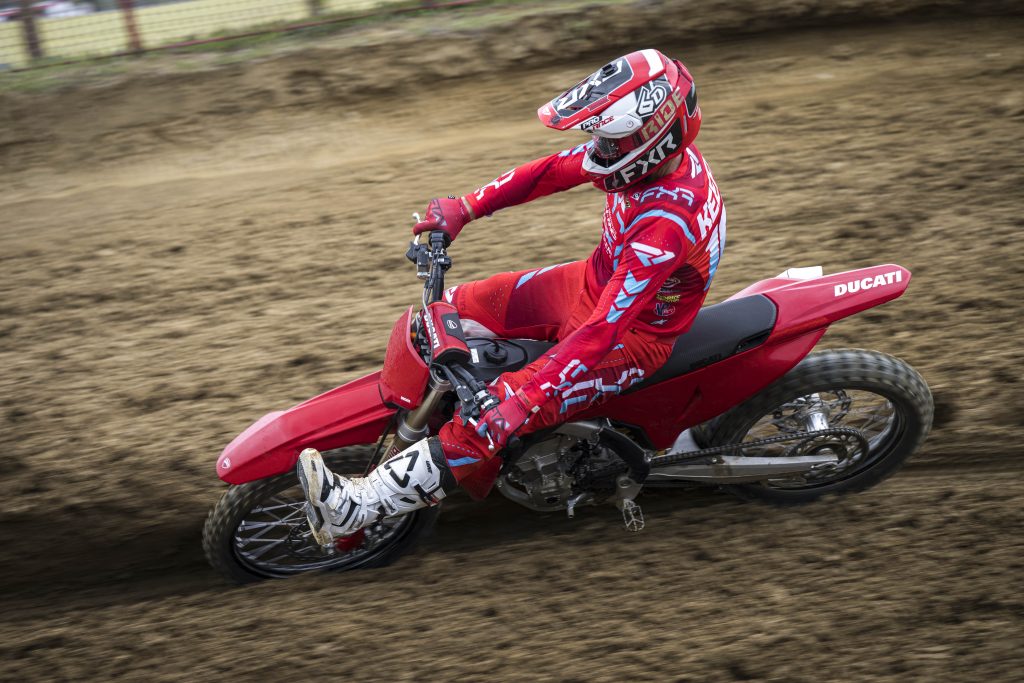
Showa Suspension: The Ducati comes with Showa suspension but what is crazy is that Ducati/Showa are using a 46N/m shock spring! WOW! This tells me that the rising rate of the linkage system is very firm. The forks are using 5.0N/m springs and I never had a issue with bottoming the forks. However, the shock felt like it got deep in the stroke and when landing off jumps the end stroke feel of the shock felt empty and soft. The sensation of the shock under heavy load feels like it has a soft spring.. The balance of the suspension felt firmer up front than the rear of the bike which can lead to a little bit of an unbalanced feel at times but after going stiffer on the high speed compression (shock) it helped bring the rear end up and gave me more front end traction when coming into corners as well as giving me more damping feel when loading the rear end. Although I can’t predict the future, I feel like this setting will be a little soft for any rider that is north of 185 pounds (when riding at American style tracks).
Map Switch Cluster Options: Ducati also has a map with that consists of two maps (aggressive/smooth), Launch Control, Traction Control and Quick Shift. I did try ALL of these features and had some success with messing with a few things. Ducati has their own phone app to be able to adjust power, engine braking, launch control and traction control. A slide bar is used with the app which makes it very friendly to use (similar to the KTM app) and just like the KTM the Ducati reacts well to less engine braking. If you feel the bike is too heavy entering corners, freeing up the engine braking will help that feeling as well as slightly make the red machine run a little cleaner below 6000 rpm. Once I turned the engine braking all the way down the bike livened up quite a bit down on lower rpm/low throttle situations. Ducati’s TC is heaps better than KTM’s or Yamahas as the Italian brand’s TC setting doesn’t upset the bike in air like some other TC settings can on other brands.
Compared To Other Machines: Of course you want to know what it’s like compared to the other bikes in its class right? Now this isn’t a true back to back test but since I am so familiar with all of the 450s, I can mention some things to help guide you in case you need to know what direction to go with your next purchase. Here’s a couple fun facts from Ducati themselves:
Claimed Maintenance Intervals:
Oil and Oil Filter Service: 45 Hours
Piston Replacement: 45 Hours
Valve Clearance Check: 45 Hours
Main Engine Service: 90 Hours
Dyno Numbers:
Peak HP: 63.5
Torque: 39.5 ft/lbs.
If I was going to describe the engine delivery to any other brand I would say that the Desmo is smoother off the bottom like a Triumph TF-450 but pulls harder through the mid range. Has a free revving feel like a Yamaha YZ450F (but freer) and doesn’t have to be shifted as soon as a Yamaha. A KTM 450 SX-F has more low end than the Ducati but the red machine pulls farther up on top end/over-rev. The engine doesn’t have much vibration so that is better than the KTM and KX but not as good as the Yamaha.
As far as the chassis feeling, the closest feeling that I get while sitting on the bike is a Honda CRF450R yet slimmer feeling. The Ducati seat is slippery and not as grippy as I would like and I think the full diamond waffle grips are no good. I would like to see a slightly less stiff feeling throttle pull. Again, these were new pre-production bikes that we tested so the quality feel of the throttle could improve for production. Overall the Ducati Desmo has its own feel but still does feel similar in some ways when compared to other bikes.
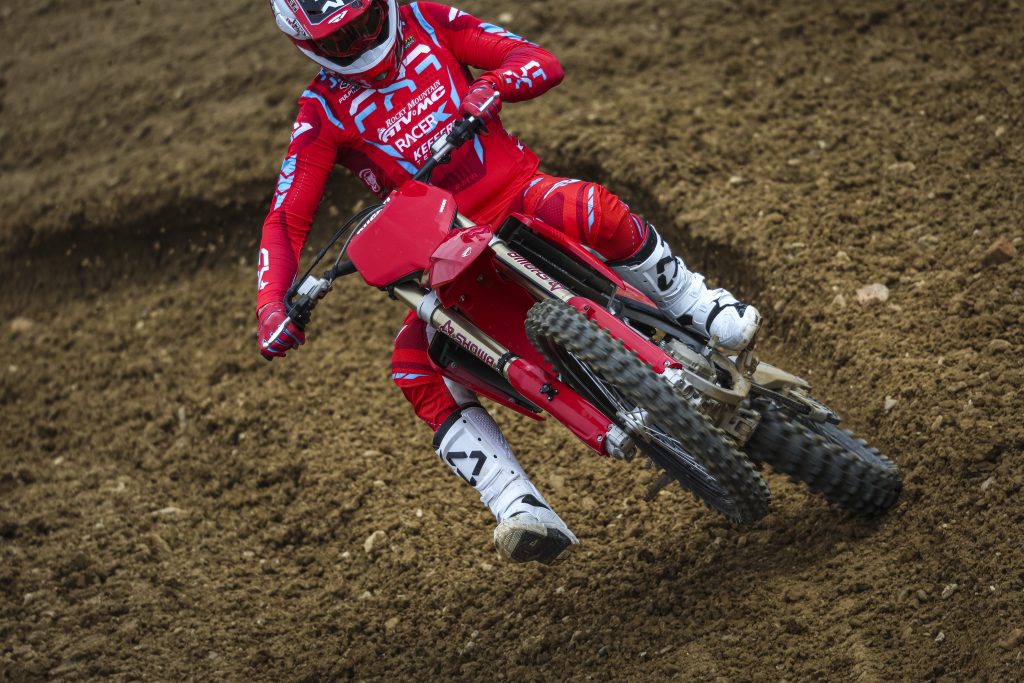
Fun Facts: Antonio Cairoli spent tons of hours on the Desmo and when I asked the Ducati higher ups about the durability process they told me they hooked top a bunch of data acquisition to the engine of a test bike and mimicked Antonio’s exact throttle percentage, RPM’s, shifting points and engine load around a few tracks. Then removed the engine from the chassis, stuck it on the engine dyno back at the factory and that dyno mimicked AC222’s quickest lap for over 40 hours non stop to ensure there wasn’t any part failures. They would leave the engine run over night for several days to see what or if any parts had a failure.
Yes, a 250 Desmo is on its way but they didn’t give us a timeline for that bike as of yet.
Not all Ducati dealerships will be receiving the Desmo 450 as Ducati North America wanted to make sure that the Ducati dealerships that will be receiving this bike were motocross/off road enthusiasts and were excited about this new bike from Ducati. Ducati didn’t want to deliver their new motocross bike to dealers that were solely street driven. Motocross bikes are so much more custom to set ups and Ducati told us that they will customize the consumer’s bike before he or she leaves the dealership with their purchase. Technicians will have tasks of setting up sag, re-springing the Desmo/Showa suspension if needed as well as make sure the rider triangle is properly set up for the customer before they even leave the dealership. This is all part of the boutique style service that Ducati is looking to bring into their motocross dealerships.
Antonio Cairoli will be racing the Desmo 450 MX at Red Bud as well as Millville this summer!
The Desmo frame only has 11 pieces to it in order to drop weight with minimal welding and to optimize rigidity. At 8.96kg it felt really lightweight when I picked it up by hand.
The Desmo weighs in a 231 pounds with no fuel but oil/coolant installed. That should put the Ducati around 241 pounds with its 1.9 gallon fuel tank full.
MSRP of the Ducati Desmo 450 MX is set to be 11,500 which is around the same as a Factory Edition type machine.


